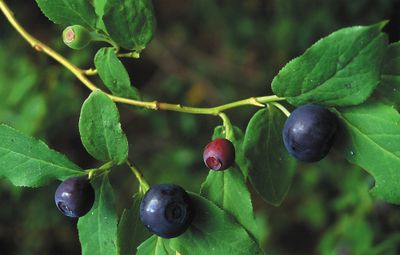Out & About: Idaho state fruit harvest has begun

OUTPICK – Huckleberries, designated Idaho’s state fruit in 2000, have been ripe for picking for a couple weeks in the low areas of Priest Lake, and the crop is gradually ripening up the mountain slopes throughout the Inland Northwest.
Don’t set your picking ambitions too high, yet.
Outdoors editor Rich Landers found ripe huckleberries for the first hour of hiking up Scotchman Peak Trail 65 northeast of Lake Pend Oreille Thursday. Above that were lots of green berries to satisfy pickers in the prime time of August.
Savvy hucksters know certain high areas, such as the Roman Nose Peak region in the Selkirks, are harvest-perfect in September.
Huckleberries flourish in several varieties across the region, from deep, purple lowbush types in the east Cascades and Pasayten Wilderness to the tiny reddish grouse huckleberry (a.k.a. grouse whortleberry) that grows 10-inches high at or above timberline in the Selkirks and Bitterroots.
The “ big huckleberry“ (a.k.a. black or thin-leaved) is the most popular berry in the Panhandle. This species grows in moist, cool forested environments at mid to upper elevations. It grows up to 3 feet tall and takes up to 15 years to reach full maturity. The single, dark purple berries grow on the shoots the plant produces that year, says ecologist Charles Johnson.
Huckleberries are a treat for humans and a necessity for the region’s bears. A poor huckleberry crop in the Priest Lake area in 1979 resulted in reduced bear productivity and survival for the next two years, according to research by John Beecham, retired Idaho Fish and Game wildlife biologist.
Black bears have flexible “prehensile lips” that can pick individual huckleberries without ingesting leaves faster than a human can harvest.
• Bears can be expected anywhere berries are ripe. Pickers should carry bear spray as a precaution.
Local historian leads wildflower walk, talk
OUTLEARN – Jack Nisbet, local writer and historian, will lead a clinic on wildflowers on Wednesday, starting with a 4 p.m. stroll through the Northwest Museum of Arts and Culture exhibit, “In the Footsteps of David Douglas.”
At 5 p.m., Nisbet will lead the group on a hike in the Iller Creek portion of Spokane County’s Dishman Hills Conservation Area to study the same monkshood, rein orchid, thimbleberry and yew trees that botanist Douglas – namesake of the Douglas fir – collected in this area in 1826.
Cost: $10. Space limited. Preregister, 466-2823.
Sierra Club leads natural area ‘strolls’
OUTDO – Sierra Clubbers are leading a series of evening walks with an environmental emphasis that runs through September in Spokane-area natural areas.
Upcoming strolls are:
• Thursday, Peaceful Valley “history tour,” 2 miles.
• Aug. 1, Dishman Hills, 3 miles.
• Aug. 15, Newman Lake, 2.5 miles.
Details: 209-2395.